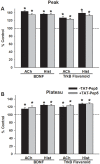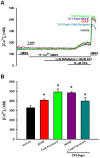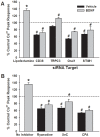Brain-derived neurotrophic factor enhances calcium regulatory mechanisms in human airway smooth muscle
- PMID: 22952960
- PMCID: PMC3430656
- DOI: 10.1371/journal.pone.0044343
Brain-derived neurotrophic factor enhances calcium regulatory mechanisms in human airway smooth muscle
Abstract
Neurotrophins (NTs), which play an integral role in neuronal development and function, have been found in non-neuronal tissue (including lung), but their role is still under investigation. Recent reports show that NTs such as brain-derived neurotrophic factor (BDNF) as well as NT receptors are expressed in human airway smooth muscle (ASM). However, their function is still under investigation. We hypothesized that NTs regulate ASM intracellular Ca(2+) ([Ca(2+)](i)) by altered expression of Ca(2+) regulatory proteins. Human ASM cells isolated from lung samples incidental to patient surgery were incubated for 24 h (overnight) in medium (control) or 1 nM BDNF in the presence vs. absence of inhibitors of signaling cascades (MAP kinases; PI3/Akt; NFκB). Measurement of [Ca(2+)](i) responses to acetylcholine (ACh) and histamine using the Ca(2+) indicator fluo-4 showed significantly greater responses following BDNF exposure: effects that were blunted by pathway inhibitors. Western analysis of whole cell lysates showed significantly higher expression of CD38, Orai1, STIM1, IP(3) and RyR receptors, and SERCA following BDNF exposure, effects inhibited by inhibitors of the above cascades. The functional significance of BDNF effects were verified by siRNA or pharmacological inhibition of proteins that were altered by this NT. Overall, these data demonstrate that NTs activate signaling pathways in human ASM that lead to enhanced [Ca(2+)](i) responses via increased regulatory protein expression, thus enhancing airway contractility.
Conflict of interest statement
Figures








Similar articles
-
Neurokinin-neurotrophin interactions in airway smooth muscle.Am J Physiol Lung Cell Mol Physiol. 2011 Jul;301(1):L91-8. doi: 10.1152/ajplung.00320.2010. Epub 2011 Apr 22. Am J Physiol Lung Cell Mol Physiol. 2011. PMID: 21515660 Free PMC article.
-
TRPC3 regulates release of brain-derived neurotrophic factor from human airway smooth muscle.Biochim Biophys Acta. 2013 Dec;1833(12):2953-2960. doi: 10.1016/j.bbamcr.2013.07.019. Epub 2013 Jul 27. Biochim Biophys Acta. 2013. PMID: 23899746 Free PMC article.
-
Brain-derived neurotrophic factor in TNF-alpha modulation of Ca2+ in human airway smooth muscle.Am J Respir Cell Mol Biol. 2009 Nov;41(5):603-11. doi: 10.1165/rcmb.2008-0151OC. Epub 2009 Feb 12. Am J Respir Cell Mol Biol. 2009. PMID: 19213875 Free PMC article.
-
Ionic mechanisms and Ca(2+) regulation in airway smooth muscle contraction: do the data contradict dogma?Am J Physiol Lung Cell Mol Physiol. 2002 Jun;282(6):L1161-78. doi: 10.1152/ajplung.00452.2001. Am J Physiol Lung Cell Mol Physiol. 2002. PMID: 12003770 Review.
-
Microdomain elements of airway smooth muscle in calcium regulation and cell proliferation.J Physiol Pharmacol. 2018 Apr;69(2). doi: 10.26402/jpp.2018.2.01. Epub 2018 Jun 13. J Physiol Pharmacol. 2018. PMID: 29920471 Review.
Cited by
-
Integrative Roles of Pro-Inflammatory Cytokines on Airway Smooth Muscle Structure and Function in Asthma.Immunol Rev. 2025 Mar;330(1):e70007. doi: 10.1111/imr.70007. Immunol Rev. 2025. PMID: 39991781 Free PMC article. Review.
-
Smooth muscle brain-derived neurotrophic factor contributes to airway hyperreactivity in a mouse model of allergic asthma.FASEB J. 2019 Feb;33(2):3024-3034. doi: 10.1096/fj.201801002R. Epub 2018 Oct 23. FASEB J. 2019. PMID: 30351991 Free PMC article.
-
Asthma: A Loss of Post-natal Homeostatic Control of Airways Smooth Muscle With Regression Toward a Pre-natal State.Front Pediatr. 2020 Apr 16;8:95. doi: 10.3389/fped.2020.00095. eCollection 2020. Front Pediatr. 2020. PMID: 32373557 Free PMC article. Review.
-
Cooperation of neurotrophin receptor TrkB and Her2 in breast cancer cells facilitates brain metastases.Breast Cancer Res. 2017 Apr 26;19(1):51. doi: 10.1186/s13058-017-0844-3. Breast Cancer Res. 2017. PMID: 28446206 Free PMC article.
-
Estrogen receptors differentially modifies lamellipodial and focal adhesion dynamics in airway smooth muscle cell migration.Mol Cell Endocrinol. 2024 Jan 1;579:112087. doi: 10.1016/j.mce.2023.112087. Epub 2023 Oct 10. Mol Cell Endocrinol. 2024. PMID: 37827228 Free PMC article.
References
-
- Friedman WJ, Greene LA (1999) Neurotrophin signaling via Trks and p75. Exp Cell Res 253: 131–142. - PubMed
-
- Kaplan DR, Miller FD (2000) Neurotrophin signal transduction in the nervous system. Curr Opin Neurobiol 10: 381–391. - PubMed
-
- Zweifel LS, Kuruvilla R, Ginty DD (2005) Functions and mechanisms of retrograde neurotrophin signalling. Nat Rev Neurosci 6: 615–625. - PubMed
-
- Chao MV (1994) The p75 neurotrophin receptor. J Neurobiol 25: 1373–1385. - PubMed
-
- Kalb R (2005) The protean actions of neurotrophins and their receptors on the life and death of neurons. Trends Neurosci 28: 5–11. - PubMed
Publication types
MeSH terms
Substances
Grants and funding
LinkOut - more resources
Full Text Sources
Research Materials
Miscellaneous

